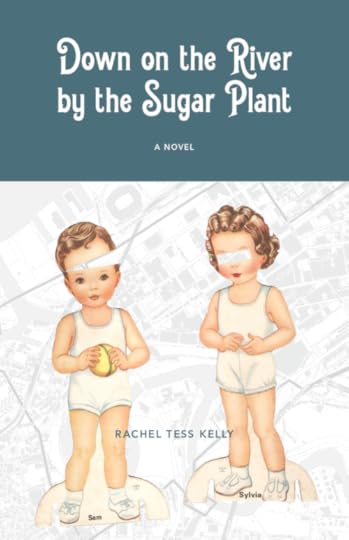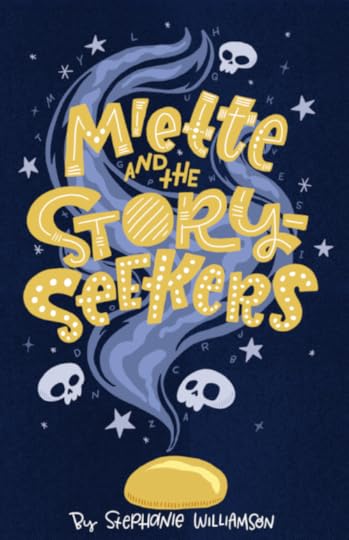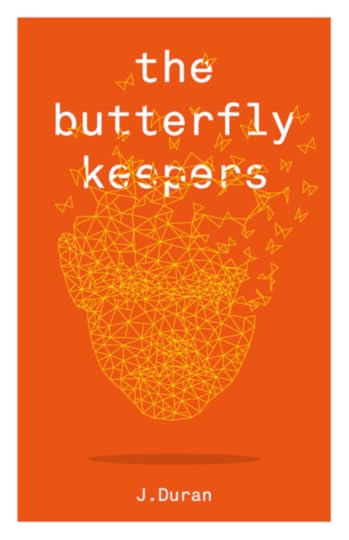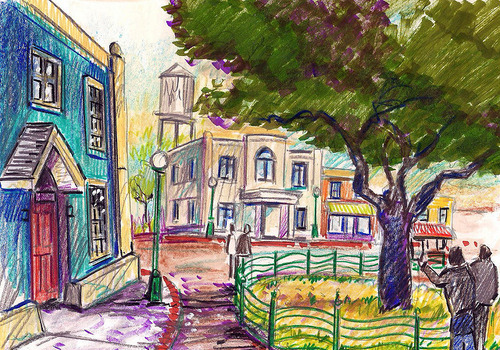Chris Baty's Blog, page 111
November 22, 2017
5 Tips to Help You Reach the Finish Line with Scrivener

Every year, we’re lucky to have great sponsors for our nonprofit events. Scrivener, a NaNoWriMo 2017 sponsor, is an award-winning word processor and project management program that has been enthusiastically adopted by best-selling novelists and novices alike. Today, they share some of their top tips to help you keep writing through the end of the month:
It’s November 22th, and for Wrimos everywhere, the end is in sight. Some of you might be putting together your finishing touches—but for many others, chances are that by this point in the month, you’re feeling pretty fatigued. Maybe you’re getting tired of elements of your story, or are stuck on resolving a particular plot point; perhaps the names of your characters don’t trip off the tongue; or perhaps you’re at that dangerous point of despair where you think the words are wonderful but they are all in the wrong order. Take heart. If any of that that sounds like you, read on…
Here at Literature & Latte, we’ve been taking part in NaNoWriMo for years, as well as answering questions from other Wrimos who have been using Scrivener—our app for writing long texts such as novels—about how it can help them keep going to the month’s end. From this, we’ve put together five tips to help you keep pushing on over the finish line:
1. Keep an eye on your targets.In Scrivener’s Mac version (and coming to Windows) you can set a deadline and then see how many words you have to write each day to reach your goal. Knowing you’ve met your target for today will make tomorrow that much less daunting.
2. Keep up that forward momentum.If you’re stuck on a section, jump ahead to another part you know you need to write. Put it into a new document in your Scrivener project and place it somewhere at the end of the Draft folder or in an “Unplaced Scenes” folder. It will count towards your word count and you can then go back and create other sections before it to fill in the gaps. Writing a later scene might just unlock ideas about what needs to lead up to it.
3. Set yourself some waypoints.Open the Draft folder in outliner mode and create some blank documents with titles and short synopses that tell you where you’re going—just rough it out. These can just be a handful of major waypoints vaguely leading to the end of your book. Now you can work towards them, filling in the spaces in between, and completing the waypoint text when you get there. They’ll sit in the binder (Scrivener’s source list) and make sure you know where you’re going. And if the plot suddenly veers, you can change them or delete them as needed. Having a destination can help you keep moving forward even if you decide to change course later.
4. Integrate your inspiration.Stuck on a description? Find an image of a character or location for inspiration. In Scrivener, you can place it in the split editor right alongside your writing.
5. Use a name generator.If you suddenly find you need to bring in a different character, don’t waste time thinking too hard about the name. Use Scrivener’s name generator. You can always use Project Replace to replace it with a name that works better later.
Most importantly: don’t despair. It’s not uncommon when you’re this far into the month to be wondering if yours is the worst draft ever written. It’s not. (You haven’t seen some our ours!) Remember Terry Pratchett’s quote about first drafts: “The first draft is just you telling yourself the story.” And Stephen King’s: “Write with the door closed, rewrite with the door open”. The important thing right now is to get your thoughts down and explore your idea’s possibilities. To help, you can switch to full screen mode in Scrivener to block out distractions and ignore the internal editor so that you can just get on and write.
And now a little note about us—if you’re enjoying using Scrivener, or are curious to find out more, we have some news. Scrivener was first unleashed upon the world right here, on the NaNoWriMo forums, way back in 2005. Twelve years later, we’ve just released our biggest update yet, with Scrivener 3 for macOS (Windows 3.0 will be following next year).
Scrivener was originally built around four core ideas: write your novel in sections as small or large as you like and easily rearrange them; add synopses to sections so that it is easy to work with an overview of the manuscript; view research and other sections side-by-side with your writing; export your work using different formatting for different requirements.
Scrivener 3 takes all of this to the next level. Scrivener’s export features are now easier to use but even more powerful. We’ve added ePub 3 and improved Kindle support. There’s a full styles system, making it easier to simpler to format your text, and you can review how much you’ve written each day using the new Writing Statistics feature. You can even track story threads with index cards on coloured lines.
All these improvements are designed to help you get writing and keep writing. We hope you’ll give them a try and enjoy using them—but most importantly, that they’ll help you get where you’re going with your 50,000 words. Good luck!
30 Covers, 30 Days 2017: Day Twenty-Two

Every November, during National Novel Writing Month, thirty professional designers volunteer to create book cover art inspired by novels being written by aspiring authors from around the globe. Why? To encourage new, diverse voices, and help build a more creative world.
30 Covers, 30 Days is presented in partnership with designer and author Debbie Millman. Read more about these NaNoWriMo 2017 novels-in-progress, and the cover designers, below.
Down on the River by the Sugar PlantA Literary novel being written this November by YWP participant Rachel Tess Kelly in the United States.
Sam Everett can read people’s thoughts, and he can reach inside their minds and pull out what he desires. Sylvia Everett can make people see what she wants them to see, and she can keep them from seeing what she doesn’t.
The Everett twins seem to be ultimate and uncontainable beings, but there is plenty to make them feel powerless in a world of politics and war and injustice. They are merely children, after all. This story is an ode to Cleveland, a celebration of the bonds between siblings, and a gentle commentary on the manner in which we speak to children about the wrongness in the world.
Cover Designed by Jane Dorn
Born, raised, and bent double as a hairpin in various versions of Small-Town Baptist USA, Jane Dorn is an educator, photographer, and graphic designer who spends her time thinking, making, and trying to give more than she takes. Visit her website and Instagram.
November 21, 2017
Pro Tips from a NaNo Coach: When Pants Become Plots

We’re nearing the home stretch with NaNoWriMo, and whether you’re on par, full speed ahead, or feel like you’re falling behind, it’s important to remember to keep your creativity alive. Today, author and NaNo Coach G.S. Prendergast shares her tips on finding ways to rediscover your novel’s plot:
By now many of you will have heard the terms “planner” and “pantser”—you might even identify strongly with one or the other. Planners (also known as Plotters) plot everything out beforehand. They write detailed outlines and sometimes even outline each scene. Pantsers on the other hand, write “by the seat of their pants”—they make everything up as they go along, with no clear idea of where the story will take them. Both types of writers can be successful. And many writers, myself included, use a kind of hybrid “plantsing” method, pantsing up to a certain point in a book then stopping to think through the rest of the story—to plot it out, as it were.
The technique of taking a short break at some point to consider the big picture can work for planners too. Often as planners write, even from very detailed outlines, they discover things they hadn’t expected that take the story in a new direction. For both planners and pantsers, an hour or two of big picture thinking can be really helpful in maintaining momentum.
Remember, there’s no need to enact any changes on the writing you’ve already done—that can be fixed in your next draft—but a better picture of your overall plot might get you back on the fast track for the remaining pages. So how do you get your mind back on big picture when you’ve been working on fine details? There are a few cute little tricks you can try. Here are some ideas:
1. Work on your pitch.These are sometimes called “elevator pitches”, ie. the way you would pitch your book if you found yourself in an elevator with, say, Steven Speilberg. Now these are more simply described as “Twitter pitches”—140 (or 280) character blurbs summarizing what your book is about. Perfecting these in the middle of your writing process helps you to crystalize your premise, your themes, and your characters, and may give you a clearer idea of the path ahead.
2. Write a Haiku.As a fun side-quest to the above, try writing a Haiku book review or summary to your book. You get seventeen syllables only, in lines of five, seven and five syllables each. You’d be surprised how well this exercise gets you to the core of your story.
3. Write (or rewrite) the summary you would use in your query.It is often said that if you can’t clearly summarize your book in 250 words then your plot has serious problems. I don’t think that’s true for all books, but writing your query halfway through the writing process will help you to check the overall health of your book. It may also help you see the path to your conclusion if that has been evading you. Out of interest, the query summaries I wrote for my books Audacious, Capricious, Pinch Me, and Zero Repeat Forever all ended up as the basis of the flap copy/marketing copy for those books!
Write out the beats of your existing and remaining plot on index cards. Use colored pens or tags keep track of multiple protagonists or subplots. Lay them out on the floor or a pin board. Once this is done you can literally step back and see the shape of your story. Is it weighted correctly? Is it balanced? Do subplots or characters disappear for long periods or dominate certain sections? Are there characters or subplots who aren’t pulling their weight and can be deleted? Where is it going?
5. Write discussion questions for your book.That’s right, discussion questions, the kind you can find on study guide websites or in the back of some “book club editions” of books. Dreaming up discussion questions will help you to think about what you are trying to say and how you might succeed in saying that in the remaining pages of your book.
One of the confounding things about novel writing is that doing it well ultimately involves more thinking than writing. While NaNoWriMo is all about writing, if you feel like your writing is stalling or stumbling or meandering aimlessly in a forest of bad metaphors, taking a little time to think about the big picture might help. The above are just a few thinking exercises you can try.
G. S. Prendergast is a novelist and screenwriter. She has been nominated for numerous awards, including the BC Book Prize, and the CLA Award. She won the Westchester Award in 2014. Gabrielle’s 2011 NaNoWriMo Novel, Zero Repeat Forever, was sold to Simon & Schuster Books for Young Readers. It published in August 2017. Gabrielle lives in Vancouver with her husband, daughter, and two chickens.
30 Covers, 30 Days 2017: Day Twenty-One

Every November, during National Novel Writing Month, thirty professional designers volunteer to create book cover art inspired by novels being written by aspiring authors from around the globe. Why? To encourage new, diverse voices, and help build a more creative world.
30 Covers, 30 Days is presented in partnership with designer and author Debbie Millman. Read more about these NaNoWriMo 2017 novels-in-progress, and the cover designers, below.
Miette and the Story-SeekersA Children’s Fiction novel being written this November by NaNo participant Stephanie Williamson in the United Kingdom.
Miette is a thirteen year old girl living with the river-folk on the canal in Bath, UK in 1910. Since the death of her younger sister a year ago, she has become obsessed with buying new books, as stories were a passion she shared with her sister and a way to cling on to her.
When she’s injured working a dangerous job to buy Peter and Wendy, her father bans her from working. The crows begin bringing her strange coloured stones, which she realises are stories that can be dreamt up in your sleep. She starts telling these to the people of Bath, attracting the attention of 14 year old Feliks.
Unknown to her, Feliks is working for Lord Ingham, a man who gathers these story stones and lets them die, then uses what they become to spread hatred, lies and evil. However, story stones only drop from peoples’ minds when they stop telling stories, so the storytelling culture of the river-folk is unknowingly working directly against Ingham.
When Feliks betrays Miette, she is kidnapped and taken to the tunnels beneath the Roman Baths, where generations of storytellers have been imprisoned and where street children are forced to work with dead stories. Ingham and his demented alchemist leave the stories to die and turn to dust and plan to make them into an elixir to control the king and ban storytelling forever. Miette must save the story stones and her family from being destroyed, all the while overcoming the death of her sister by telling her story.
Cover Designed by Shauna Lynn Panczyszyn
Shauna Lynn Panczyszyn is a hand lettering artist and illustrator located in Orlando, Florida, where she works out of her home studio with her pup, Mister Teddy Bear. She has had the opportunity to work with brands such as Harper Collins, Scholastic, Adobe, Microsoft, and many others. She loves to create whimsical art that makes people happy and enjoys working on projects geared towards children. You can see more of her work at www.shaunalynn.com, and follow her on Twitter and Instagram at @shaunaparmesan. She is also a creative streamer on Twitch where you can watch her work at twitch.tv/shaunalynn.
November 20, 2017
How NaNoWriMo and Kindle Scout Turned One Writer into a Published Author

Every year, we’re lucky to have great sponsors for our nonprofit events. Kindle Scout is reader-powered publishing for new, never-before-published books. It’s a place where readers help decide if a book gets published. Of the over 75 titles readers have discovered through Kindle Scout, many have roots in NaNoWriMo. Learn how Kindle Scout helped author Jasmine Silvera go from plotting to published:
I’ve always said I’d move anywhere for love. When my husband’s job sent us from Seattle to the Czech Republic, I left behind a gig teaching yoga and the vibrant speculative fiction writing community I had been a part of for nearly a decade to embrace life in the magnificent city of Prague.
Prague is an enticing combination of the foreign and the familiar. Its superb architecture and complex history make it easy to find inspiration around every corner. But It wasn’t until I met another expat and writer that inspiration turned to story. Mystery writer Beth Green suggested we do NaNoWriMo together. For the first time, I imagined life in an alternate Prague full of magic. As the weather settled into the chill and dark of late fall, we met in coffee shops all over the city to plan our month of writing.
I’d always been a writer, but aside from a short story or two, publication had been out of reach. Fearing plotting would kill my creative process, I was a die-hard pantser. I’d taken part in NaNoWriMo several years in a row and won with ease. But those attempts ended in messy, unfinishable books. I decided with only 30 days “to lose,” I’d plot the entire novel before writing a scene.
I started NaNoWriMo that year, not just writing the story, but also spending time with my characters, learning their motivations and fears. Location research amounted to long walks around the city and tours of historic sites. It took longer than I expected. By end of the first week of NaNoWriMo, I had the outline for a complete novel: 27 chapters including scene ideas.
I was also way behind on my word count. I feared that the plotting experiment would cost me my win that year. Beth and I met several times a week, and I often squeezed in a few more hours each night at home. When I got stuck, I had my outline for reference. But increasingly, writing felt magical: by knowing where my characters needed to be from chapter to chapter, bridging the gaps was effortless.
“The risk I took to plot during NaNoWriMo showed me that sometimes doing something familiar in a new way pays off.“Though I didn’t beat my personal best NaNoWriMo word count (104k words is a tough bar!) I had something even better: a complete novel. The 30-day limit empowered me to take a chance with a new writing strategy. That gamble paid off.
I spent a year revising Death’s Dancer, working with an editor and beta readers to get it right. When a friend sent me a link to Kindle Scout, I had my doubts: no one I knew had ever done anything like it. But after researching the program, I found the process of "reader-powered publishing” intriguing.
After submitting the book through the Kindle Scout website, there’s a brief review period (usually just a day or two), to make sure the book meets some basic requirements. Readers then have 30 days to vote on an excerpt of the book, and an editorial review factors into the final decision to offer a publishing contract. I would have a decision in 45 days. Compared to industry stories of querying agents and editors for months or years, Kindle Scout would give me quick feedback and allow me to reach potential readers.
It’s a new way of publishing. The risk I took to plot during NaNoWriMo showed me that sometimes doing something familiar in a new way pays off.
The Kindle Scout campaign for Death’s Dancer ran in the summer of 2016 and it was selected for publication. My favorite part of being an author is hearing from readers: finding out their favorite character, and moments in the story that moved them.
Thanks to NaNoWriMo and Kindle Scout, I have the best souvenir from my time in the Czech Republic: the start of a writing career.

Jasmine Silvera followed her love of writing to Seattle, where she now lives with her family after 2 years abroad. She enjoys practicing yoga, photography, and relearning to dance. Death’s Dancer is her first novel. The sequel Dancer’s Flame is forthcoming in early 2018. She is @jassilvera on social media, and posts upcoming release news at www.jasminesilvera.com
30 Covers, 30 Days 2017: Day Twenty

Every November, during National Novel Writing Month, thirty professional designers volunteer to create book cover art inspired by novels being written by aspiring authors from around the globe. Why? To encourage new, diverse voices, and help build a more creative world.
30 Covers, 30 Days is presented in partnership with designer and author Debbie Millman. Read more about these NaNoWriMo 2017 novels-in-progress, and the cover designers, below.
Fantasy = RealityA Young Adult novel being written this November by YWP participant Troye in the United States.
When Yvaine King was five years old she, her chihuahua Tristan, and her dads moved to the woods in their little Airstream to film a movie. They had only planned to stay a few months, but when the movie became a TV series, they ended up staying more than ten years, which gave Yvaine plenty of time to become friends with Lynn Garside, a girl who lives just up the hill. Even though the two had opposing views on many different things, they bonded.
Now in her late twenties, Yvaine returns to those woods, this time filming her own work, inspired by her family history. She already wrote a top-of-the-charts movie, but due to some teenage stupidity on her part, she gave the script to her dads, completely cutting herself out of the deal. Now her dads are living the celebrity life because of that film; and, now, she’s determined to prove herself.
Told in alternating scenes from her film and her childhood, Yvaine tells a story of growing up where fantasy is a reality, friends are family, and death is always hiding in the forest, whether it be the grim reaper or someone closer…

David Hisaya Asari is a graphic designer and design educator based in Oakland, California. He is an Associate Professor at California College of the Arts, teaching in Graphic Design, First Year, and Special Programs. David is President Emeritus of the San Francisco chapter of AIGA, the professional association for design. Niente senza gioia!
November 19, 2017
30 Covers, 30 Day 2017: Day Nineteen

Every November, during National Novel Writing Month, thirty professional designers volunteer to create book cover art inspired by novels being written by aspiring authors from around the globe. Why? To encourage new, diverse voices, and help build a more creative world.
30 Covers, 30 Days is presented in partnership with designer and author Debbie Millman. Read more about these NaNoWriMo 2017 novels-in-progress, and the cover designers, below.
The Butterfly KeepersA Satire/Humor novel being written this November by NaNo participant J. Duran in the United States.
Everyone knows that everything in the known universe is connected. Not as well known is the fact that everything is connected by the fine silk thread of a small caterpillar.
These caterpillars create the connections between a person and the parallel universes that are created from each decision they make. These connections are important, and the break in a connection can result in a consequence as simple as
déjà vu—or as disastrous as the collapse of a civilization, the destruction of an entire planet, or the birth of a black hole.
To make things more complicated, these caterpillars are made of the pure essence of space-time and, when eaten, give the consumer eternal life. As a result, they are powerful weapons of destruction or creation, depending on your point of view. It is from those whose point of view is destruction that the One tries to keep these secrets. And to that end, the Keepers were sent to nurture and protect the caterpillars and their butterflies…
Keeper 67 loves his job and is proud to be a Keeper. He is the epitome of the perfect Keeper, and in fact, he has just won the highest honor given to Keepers: that of giving the Lesson. What he doesn’t know, is that he is about to make the biggest mistake that the universes have ever seen. Pandemonium, chaos and Cheeto-eating will ensue and the universes will never be the same.

Christopher Simmons is a designer, author, design advocate, and principal of the San Francisco design office, MINE . He speaks on design issues for colleges, professional associations, and media, and regularly participates as a judge for major design competitions. Christopher’s work has been exhibited in museums and galleries ranging from The Hiroshima Museum of Contemporary Art to The Smithsonian Institution. He is the author of four books, an editor at Design Observer, and a creator of text-based art.
November 18, 2017
30 Covers, 30 Days 2017: Day Eighteen

Every November, during National Novel Writing Month, thirty professional designers volunteer to create book cover art inspired by novels being written by aspiring authors from around the globe. Why? To encourage new, diverse voices, and help build a more creative world.
30 Covers, 30 Days is presented in partnership with designer and author Debbie Millman. Read more about these NaNoWriMo 2017 novels-in-progress, and the cover designers, below.
Doctor PlagueA Science Fiction novel being written this November by YWP participant T.J. Comix in the United States.
Grant Miller is a 26 year old guy from the ghetto. His father left him when he was little, and his mother was killed by a local gang when he was 16. He found out that his father was the leader of that gang, and became even more angry.
Eventually, he went to college in Detroit and became an Advanced Mechanical Engineer (A.M.E). He used his knowledge of mechanics and constructed a Cyberpunk Plague Doctor suit of armor and became the Superhero known as…Doctor Plague!
Cover Designed by Martin Batt & Anders Godal

Martin & Anders are cofounders of The Creators Club, a strategic design studio that creates winning strategies and compelling experiences through multi-disciplinary capabilities. Both are award winning designers and holders of D&AD Yellow Pencil’s for brand identity design. They’re always striving to develop strategies and solutions that are out to change the world and our experiences of it through experimentation and flair. Visit their website, Instagram profile, or Twitter @creatorsclubLDN
November 17, 2017
It Takes a V.I.L.L.A.G.E. to Make a Writer

With November upon us, it’s a great time to reflect on what makes you the writer you are, and how the rest of the NaNo community can help you complete your novel. Today, Municipal Liason Sarah Peloquin shows us how it “takes a village” to make a writer:
I enjoyed solitude as a child. Now, as a parent of four little minions, alone time is a rare and beautiful treasure. When I first began honing my writing, I thought, Perfect. Writing is an alone sort of activity and I’m an alone sort of gal.
And writing is, in one sense, a solitary matter. No one else will ever write you.
Your creativity and imagination spilling out onto blank pages is solely yours.
At the same time, your inspiration for writing is the product of life experiences and the community of people that shaped you. A hermit in a dark, cold cell will never have the same ability to create a story as a person who has tasted and seen and touched and heard and felt the world around them in all its exquisite glory.
When I say it takes a VILLAGE to make a writer, here’s why:
Virtual – Our world has expanded with the expansion of technology. We now have ways of connecting to our fellow writers that we never dreamed of one hundred years ago. Get involved in the online chats, twitter word sprints, and NaNoWriMo’s own amazing regional forums to connect to others who are on the same journey, in the same part of the world, with you this November.
Inspiration – NaNoWriMo’s forums are amazing for offering new writing challenges, writer pen pals from around the world, mentors who’ve seen it all and lived to tell the tale, and even threads just for those times when the blank page is your worst fear realized.
Links – To Write-ins at your local libraries, coffee shops, bookstores, and more. Calendars of events, both the official NaNoWriMo one and those compiled by volunteer Municipal Liaisons, who work tirelessly at bringing you the resources you need to succeed at this 30 day writing challenge. (I’ve heard chocolate is a good incentive for MLs in lieu of payment)
Life – Happens and it’s amazing to me every year when my own brilliant region circles the wagons to support a struggling writer through a difficult time. Care packages for the sick, an emergency online meet-up when the words just won’t flow, or just a note of encouragement to remind someone that not meeting their writing goal in November is NOT failure by any stretch of the imagination.
Affirmation – Whether it’s winning a contest for the most words written or a Hip, HIP, HUZZAH for even making it to a write-in after the car broke down, the baby-sitter was a no-show, or the house nearly burned down right before you left because your husband was trying to be helpful by making dinner for you. We all need to hear words of encouragement for our efforts. A community of writers brings that in abundance in my humble experience.
Galvanized – This word is NOT used often enough in my opinion. What better place for a writer than a community (online or otherwise) of fellow writing warriors who can give us the kick in the pants we need on those days we don’t want to stare at another blank screen?
Educational – Writing is an ongoing learning project and there is no greater way to continue honing your craft than building a diverse community of writers around you. You get better the more you learn.
Your writing world will expand this November, and it’s time to jump right into the fray. Find your region, build relationships, and for goodness sake, write!

Sarah Peloquin loves great books on rainy afternoons, whether it’s The Chronicles of Narnia read aloud to three (almost four) squirmy children or her favorite history, poetry, or parenting books. She homeschools her aforementioned tiny minions with her amazing husband in Midwest, North America. She found NaNoWriMo in 2008, but didn’t get serious about it until 2010. Sarah took on the challenge of Municipal Liaison in 2014 and enjoys her region immensely. You can find some of her scribblings and inspirational posts at: Musings on a Life Lived and Instagram.
Top image licensed under Creative Commons from behindthethrills on Flickr.
30 Covers, 30 Days 2017: Day Seventeen

Every November, during National Novel Writing Month, thirty professional designers volunteer to create book cover art inspired by novels being written by aspiring authors from around the globe. Why? To encourage new, diverse voices, and help build a more creative world.
30 Covers, 30 Days is presented in partnership with designer and author Debbie Millman. Read more about these NaNoWriMo 2017 novels-in-progress, and the cover designers, below.
The Circle MakerA Horror/Supernatural novel being written this November by NaNo participant Kelsey Wofford in the United States.
Anna Worley was an amenable young woman and more concerned with her own thoughts than the outside world. But Violet…Violet was everything that Anna was not: feisty and impetuous. She delighted in the pleasures the world had to offer and lived her life exquisitely.
After Violet’s sudden death and the discovery of an obscure manuscript among her personal affects, Anna becomes convinced that she was involved with a secretive occult society. Following the trail left by a stranger at Violet’s funeral, Anna disguises herself as a young man named Thomas and takes up an apprenticeship with a mortician in London—but finds the city in turmoil.
A madman is on the loose that the newspapers are calling the Circle-Maker because he leaves behind large circles with esoteric symbols burned into the ground in churches and graveyards. Soon enough, young women begin disappearing and later turning up dead with no evidence outside of the mysterious circles. Anna believes that the answer to the murders could lie with the Operation of Abraham, a ritual that has only been completed once in all of history, but the only person who knew anything about it…is dead.
Cover Designed by Randy Gregory
Randy Gregory II is a designer & artist living in Austin, Texas. He spends his days as a Design Strategist for IBM, focusing on Watson and the future of cognitive design. When he’s not at IBM, Randy engages in more hobbies than he can count, including but not limited to: putting on double features for friends, cooking Korean food, going to Improv class at Coldtowne Theater, playing with synthesizers, hanging out with his awesome corgi, donating time to AIGA & Austin Design Week, and playing Dungeons & Dragons twice a month. Follow him on Instragram at @randygii or check out his portfolio at theinternetofuselessthings.com or randygregoryii.dunked.com.
Chris Baty's Blog
- Chris Baty's profile
- 63 followers



